Workflow management is a crucial part of organizing and optimizing projects. Learn everything you wanted to know about workflows in this guide.
What do project managers love even more than on-time and under-budget delivery?
Workflows.
Workflows bring much-needed order and predictability to the project management process. If you can map it out as a workflow, you can most likely scale and optimize it.
Workflow management is an entire discipline in project management. Mastering it is crucial if you want to bring efficiency to your projects.
This guide will cover every aspect of workflow management. You’ll learn the ABCs of workflows, how to map them, and how to optimize them for maximum impact.

Section I: Understanding Workflows and Workflow Management
Workflows essentially deal with the flow of information. If you’ve ever managed any projects, you’ve used workflows in some for - even if you don’t formally recognize them as such.
Understanding workflows and their management is the first step in using them effectively. We’ll cover workflows, their use, and their benefits in detail in this section.
What is a Workflow?
Wikipedia defines workflow as:
“an orchestrated and repeatable pattern of activity, enabled by the systematic organization of resources into processes that transform materials, provide services, or process information.”
In simpler words, a workflow is a structured set of activities.
To understand workflows, you have to first understand two core concepts in business process management (BPM): flowcharts and state machine diagrams.
Most of us are familiar with flowcharts. In its simplest form, a flowchart describes the “flow” of information or activities, depicted graphically. You might use formal chart symbols to describe this movement (such as ‘terminator’ or ‘decision’ charts).
For the most part, however, a flowchart is simply a graphical representation of a sequence of activities.
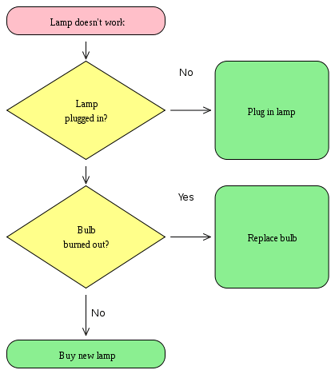
A simple flowchart (source: Wikimedia)
Project managers, programmers, and anyone who has ever used a Kanban system would be familiar with state machine diagrams. These diagrams depict the “state” of individual tasks. The most common states are:
- Open
- In-Progress/Doing
- Resolved
- Closed
- Reopened
Managing tasks within this framework means moving them from one state to another. Any task that’s actively being worked on, for instance, would move from an “open” to an “in-progress” state.
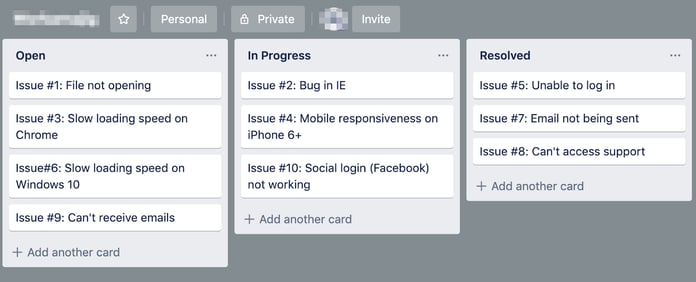
The Kanban system uses ‘states’ to manage tasks and projects
While both flowcharts and state machine diagrams are useful for managing projects, they both have clear deficiencies. State machine diagrams don’t describe the flow of activities. And flowcharts don’t describe their state at different points.
Workflows solve both these problems.
A workflow can be either sequential or in the form of a state machine.
Sequential workflows describe a linear list of activities, such as a Waterfall or Critical Path workflow. Sequential workflows offer a great deal of control and predictability to the production process.
State machine workflows describe a workflow with distinct states, such as Agile or Kanban. State machine workflows are more flexible and give project managers the ability to move back and forth in the development process.
Thus, a workflow can show the flow as well as the state of all activities included within it. Essentially, a workflow consists of:
- The steps necessary to complete a work item
- The resources required for each step
- The people responsible for each step
- The interaction between different steps
Here’s an example of a workflow [example]
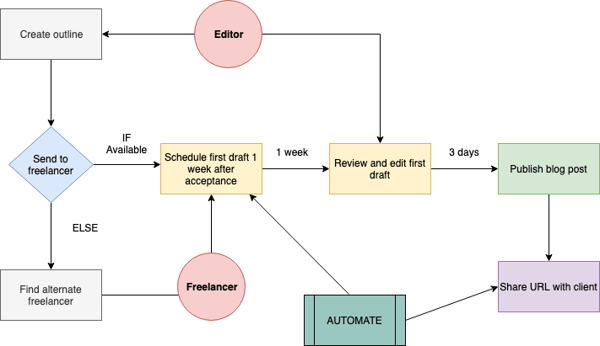
Workflows bring much-needed predictability to your management process. All things being the same, a workflow with fixed input should always yield the same results.
This predictability makes it easy to scale and optimize your work. Once you’ve mapped out a workflow, you can spot inefficiencies in it. Since the results of an optimized workflow are predictable, you can also scale it from 1 to N number of outcomes.
Workflows, Processes, and Checklists
You might use terms like “workflow” and “process” colloquially, but within the project management context, they stand for very different concepts.
A process is a broad term to describe all the activities - tangible and intangible - that go into creating a deliverable. A workflow consists of only the tasks necessary to produce a work item. But a process includes all the data gathering, reporting, brainstorming, and negotiations that go into producing the deliverable.
For instance, when we talk about the “project management process”, we talk about the planning, execution, monitoring, and reporting activities necessary to take a project from start to finish. This is an incredibly broad “process” with countless workflows.

A plan, colloquially, might describe a set of activities and the rules governing them. But in the project management context, a plan means something specific - everything that’s needed to take a project from start to finish. This often includes related plans such as resource, risk, and scope management plans, etc.

A single plan might have several workflows associated with it. For instance, a communication plan might have separate workflows for handling communication with:
- Project sponsors
- Internal stakeholders
- Team members
Workflows are sometimes represented as checklists since they’re easier to create than graphs. However, checklists don’t have either the state or the flow information of a workflow. Instead, they simply show a list of activities that must be completed, often in no strict order. There is no “if-then” decision tree system that’s the hallmark of a workflow.
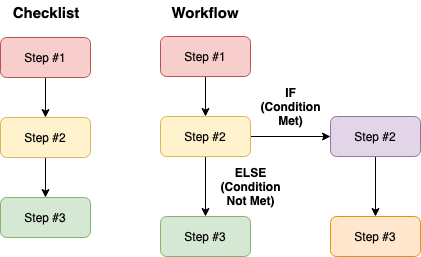
A single workflow might have several activities, and each of these activities might have separate checklists associated with them.
Thus, you can represent all these terms as follows:
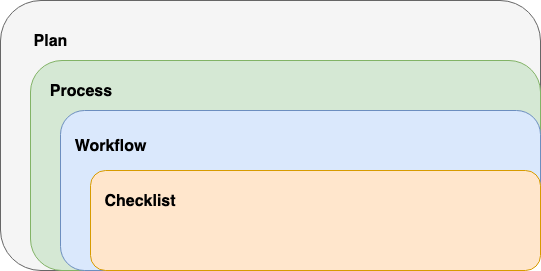
This should clear some of the confusion around workflows.
What is Workflow Management?
This brings us to the all-important question: what is workflow management and why should you care?
Workflow management is the process of describing, organizing, and managing workflows. Its aim is to achieve efficiency and scalability by optimizing and automating your workflows.
For instance, you might have a workflow for onboarding new employees. After creating this workflow, you might find that you can automate the onboarding emails. You can also schedule the training session automatically instead of assigning it by hand.
Spotting these inefficiencies and automating them comes under the purview of workflow management.
Workflow management vs project management
Workflow management is essentially a part of business process management (BPM). Its goal is to find, describe, and optimize project activities. Workflow management works best when it’s used for tasks that can be scaled predictably.
Project management, in contrast, is the much larger process of describing, coordinating, planning, and controlling projects. This includes both predictable activities (such as onboarding a new client) and complex, unique activities (such as developing creative collateral for a marketing campaign).
In a way, you can say that workflow management is a part of project management. All the repeatable activities in a project that can be scaled are bundled under workflow management. The rest are handled as part of your project management process.
What is a Workflow Management System?
A Workflow Management System (WfMS), as you guessed it, is a software system for managing and optimizing workflows.
A good workflow management system allows its users to create different workflows based on circumstances, roles, and needs. It also includes automation features to maximize the efficiency of every workflow. Ideally, it should support multiple types of workflows based on flow or state.
Most workflow management systems are typically bundled as part of a larger project management system. For example, Workamajig supports both Agile/Kanban and Critical Path/Waterfall workflows. This gives project managers a lot of flexibility in choosing the right workflow for different activities.
What Are the Benefits of Workflow Management?
If you’re already using project management or task management, do you really need to invest in workflow management as well?
This might sound like a moot question, but you’ll be surprised at the number of busy project managers who ask us this every week.
And they do have their reasons.
Workflow management is all about defining and improving existing activities. While this is certainly important, it can’t take precedence over your main duties as a project manager: defining, planning, and executing projects.
Once you have a handle on your project management process, you can sweat the small stuff - workflows.
When you do get to it, you’ll realize that workflow management can bring order to the chaos of your projects.
1. Streamlined and optimized processes
Mapping your workflows can give you a great deal of insight into optimizing their execution. You’ll often spot redundancies and opportunities for automation that might have otherwise gone unnoticed.
For example, you might have a workflow where a creative submits a design to the project lead. The project lead sends it to the client who, in turn, shares her feedback over email with the project manager. The manager shares it with the project lead who passes it on to the creative.
This entire process has several opportunities for improvement. Depending on how your team is set up, you could:
- Have the creative send the designs directly to the client (especially for low-level deliverables)
- Use an online proofing tool to collect feedback within your project management tool, bypassing email
- Have the project lead deal directly with the client, bypassing the project manager
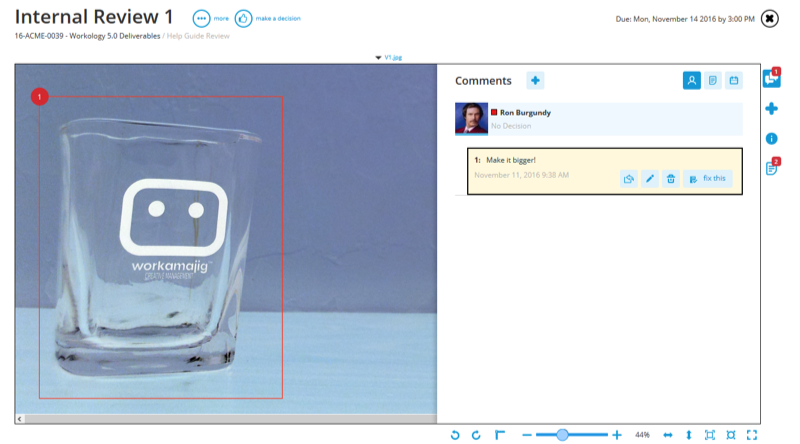
Using Workamajig’s proofing tool makes it easy to collect feedback from clients, bypassing email entirely
Each of these approaches can improve the approval process. This wouldn’t be possible without mapping out your workflows.
2. Reduced risk
“Risk”, for project managers, is unpredictability.
Not knowing the status of a task or the next activity in a creative process greatly increases project risk. You can’t really tell if a project is behind schedule if you don’t even know how long the current activity will take.
This is where workflows help a great deal. Workflows break down complex processes into smaller, predictable tasks. You might not know how long that website redesign will take. But you do know that it takes you 4 days to collect requirements and 5 days to create the first mockup on average.
This knowledge can help you predict the status of each activity better. And this equates to lower risk and better project visibility.
3. Greater scalability
One of the hallmarks of a well-crafted workflow is scalability. All things being the same, a workflow with a fixed input will always yield the same result.
Think of a project status report workflow. This workflow uses a fixed template. Input the same data fields every time and you’ll get a complete report, no matter what project you’re working on.
Furthermore, defining activities as workflows means that they’re no longer tied to individuals. A predictable activity with a fixed workflow can be done by anyone, not just the person who created it.
This scalability is crucial for agencies. It allows you to outsource or automate all repeatable tasks and frees up resources for what really matters - creative work.
4. Other benefits
That’s not all - workflow management can help in other ways as well, including:
- Transparency: Workflows enable better access to data. At any point, you know exactly what data is being produced and how it is stored. There is less obfuscation and more transparency, improving decision-making.
- Accountability: Every stage in the workflow is attached to a specific individual or department. You know exactly who is responsible for each activity, leading to greater accountability.
- Easier auditing: Want to revisit a project to audit its performance? A workflow makes things easy by showing you exactly who did what at which stage of the project. If a certain department took six weeks instead of four to complete a task, the workflow will show you.
There is no reason not to use workflow management in your projects. But the question remains: how do you go about using them?
Let’s find some answers in the next section.

Section II: Creating and Using Workflows in Project Management
Project management is the science of predictability and order. Success for a project manager is a project that goes exactly to plan.
Workflows are a powerful weapon in your arsenal for achieving this aim. If you can map it as a workflow, you can reliably predict its outcome.
In this section, we’ll talk about the process of defining workflows and using them in your projects.
Where and When to Use Workflow Management?
Not every activity in a project is a good candidate for workflow management.
Broadly speaking, everything you do in a project can be broken down into two categories:
- Fixed, repeatable activities common to all projects (within a specific category)
- Unique activities specific to the project
In project management terminology, these are called “process” and “case” workflows, respectively. The former can be broken down into a process, while the latter has to be approached on a case-by-case basis - hence the name.
For example, every app your agency builds is different. But to capture the requirements, you send all clients the same creative brief template.
In this case, the app designing process is a case workflow while sending the creative brief is a process workflow.
Workflow management works best when you’re dealing with fixed, repeatable activities. One-off activities that require unique solutions are poor candidates for workflow management. You might be able to break them down into workflows, but since you can’t repeat them across projects, your efforts would be wasted.
Gathering requirements, creating communication plans, and onboarding employees - these are all good candidates for workflow management. All these tasks are usually the same across projects. You’ll gather requirements the same way regardless of whether you’re working on a $100 or $100k app design.
Identify Repeatable Activities
Your first task in workflow management, thus, should be to identify all the fixed, repeatable activities you undertake during a project.
Work your way backward from a successful project. What did you do to arrive at this point? What documents and deliverables did you create - for clients and for internal teams?
It’s a good idea to break down all these activities into different phases. Each of these phases would have certain activities and deliverables associated with them, such as:
- Initiation: Client onboarding, gathering requirements, developing a project charter
- Planning: Scope statement, communication, and risk management plans, WBS, budget, project schedule
- Execution: Status reports, forecasts, resource management
- Monitoring: Budget, activity, and goal tracking
A lot of these activities are repeatable entirely or in part. Your goal should be to identify all the parts that can be broken into a fixed workflow.
For example, you might send clients a monthly report with key metrics and top issues that need their attention. Gathering key metrics can be easily automated. The project manager only needs to jump in when curating the list of key issues.
Thus, you might have a workflow like this:

The project manager only needs to jump in when handling the activities listed in the red box. Everything else can be automated.
Within this workflow, some parts are repeatable, and some unique to every report. By breaking it down this way, you involve project managers only when they’re truly needed. The rest is handled by your workflow management system.
If you can do this for all your activities, you’ll save a ton of time.
What Type of Workflow Should You Use?
As we learned earlier, workflows can be broadly divided into two categories - sequential and state machine workflows.
A key tenet of successful workflow management is to use the right workflow for the right task.
Generally speaking, linear processes with fixed deadlines and predictable paths to completion are best defined in sequential workflows. Since the order of activities and their schedule is known, it is easy to map out the workflow as a sequence.
The two most commonly used sequential workflows are Waterfall and Critical Path. Workamajig supports both.
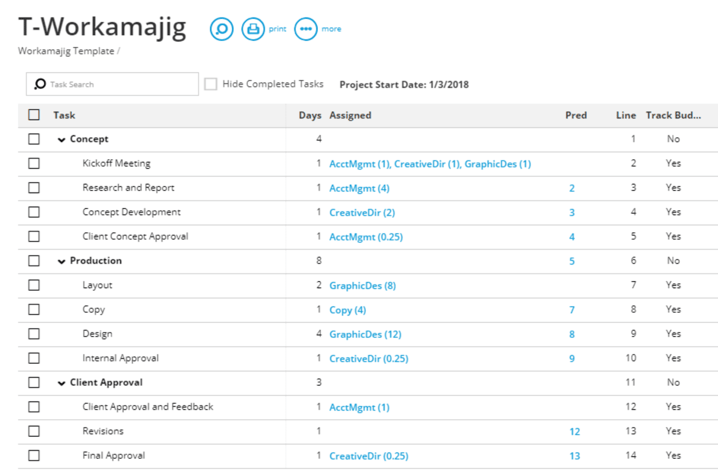
The critical path method uses fixed schedules for all activities
Use this workflow for all your scalable and predictable activities. Creating communication plans, onboarding employees, creating status reports - none of these have any element of uncertainty. You can reliably map them out as a flowchart with fixed periods for each step in the workflow.
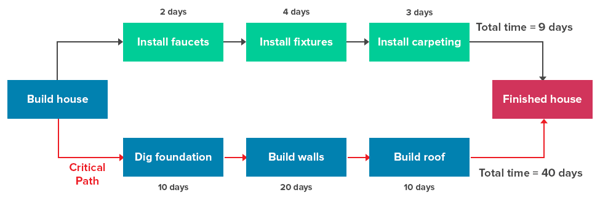
An example of the critical path workflow with a fixed time period for individual steps
Sequential workflows do suffer from an excess of planning. Should something go wrong, the workflow schedule can be hard to fix.
This is why tasks with complicated and changing requirements are best mapped with state machine workflows.
In this workflow, the “state” of an activity (such as “open”, “in progress”, or “closed”) takes priority over specific deadlines and schedules. The order and duration of individual tasks are fluid. A task can move from one state to another and back as often as needed.
Such workflows work best for open-ended activities such as design and programming. It’s not always easy to plan the duration of each task when developing a program. You might think you’ve wrapped up the coding process only to spot a bug that would force you to reopen the code again.
Thus, for such activities, use open-ended state machine workflows with flexible deadlines. Give your team members the room to move from state to state as necessary.
Workamajig supports Agile/Kanban workflows. Instead of a list of tasks with a fixed duration, your team will see a list of activities they have to complete for the week/day.
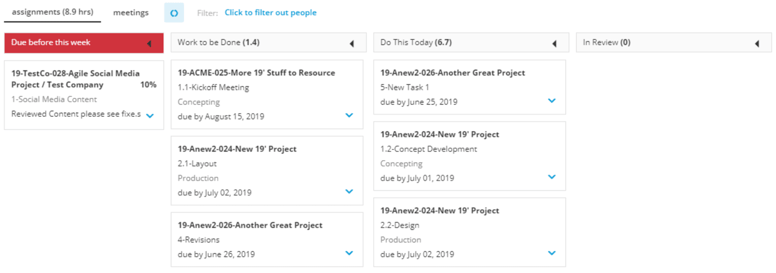
To recap:
- Use sequential workflows for predictable tasks with easily mappable deadlines
- Use state machine workflows for open-ended tasks with unpredictable deadlines
Workflow Management: Creating and Optimizing Workflows
Identifying activities that can be turned into workflows is the first step in the workflow management process.
The next step is actually creating each workflow.
Follow these tips to make the process smoother:
1. Identify stakeholders and their roles
Once you’ve listed the activities that can be turned into workflows, your next goal should be to identify all the stakeholders involved in it.
This should include everyone on both sides of the table - sponsors as well as team members.
For each stakeholder, identify what role they play in the workflow. Roles can be:
- Executive, i.e. directly act on one or more activity in the workflow (such as team members)
- Collaborative, i.e. they contribute their input to the workflow but don’t have an impact on its execution (such as sponsors sharing their requirements).
- Decision-making, i.e. they decide whether an activity can move to the next stage (such as a sponsor or editor approving a deliverable).
2. Collaborate with stakeholders
Next, work with all the stakeholders you identified above when mapping out your workflows. This will help in two ways:
- You’ll be able to spot inefficiencies before they even arise
- You’ll be able to create more stakeholder-friendly workflows (and not just “manager-friendly”)
For instance, working with a decision maker might reveal that if you involve them in the approval process early in the workflow, you can avoid revisions later. Similarly, a team member might reveal a better path to getting work done than the one you’re currently using.
Don’t hesitate to get in touch with external stakeholders - clients - as well. Ask them if there is anything they’d want you to do differently in the way you work. You’ll be surprised how many clients will happily offer you free advice that makes their - and by proxy, your - work easier.
3. Work your way from a rough to a refined workflow diagram
Mapping your workflows should be a little like sketching. Start with a rough outline then fill in the details as you collaborate with your stakeholders.
The first iteration of your workflow diagram should list:
- A broad set of activities involved in the workflow
- The people or departments involved in each activity
- The movement of responsibility from one group to another
Take this as the base for your collaboration process. Ask stakeholders in each stage to tell you their optimum process for completing the activity.
Remember that your stakeholders understand the execution process better than you. They’ll often show you fixes that will save you tons of time in optimization in the future.
4. Spot redundancies
The first time you map your workflows, you’ll be surprised at the number of redundancies you’ll find. Tasks that are no longer necessary, activities that are repeated several times, and workflows that go nowhere are common, even in the best-run agencies.
After defining your workflows, dig through to spot redundancies. In particular, look for the following:
- Repeated work, either within or outside the workflow. For example, you might have a situation where you end up creating multiple templates for the same deliverable across different workflows.
- Redundant activities that do not contribute to the final deliverable. For every activity in the workflow, ask: how does this help us in creating the deliverable?
- Activities that can be clubbed together or carried out simultaneously. For instance, you can use an online proofing tool to collect feedback and get approval from the client at the same time (instead of going back and forth over email).
If you’ve actively collaborated with different stakeholders through the workflow creation process, these redundancies should be few and far in-between.
Once you’ve identified them, the next step is to further optimize each workflow.
5. Automate and outsource
As you comb through your workflows, you’ll inevitably find activities that can be automated. Others can be outsourced to a third-party contractor for cheap.
Do you really need the project manager to manually email the project lead about upcoming deadlines? Do you truly want your $100/hour marketers scraping data to fill a spreadsheet?
These are examples of activities that can be easily automated or outsourced. Prioritizing them during the optimization process will be your biggest source of efficiency.
Of course, the entire process of defining, managing, and optimizing workflows becomes much easier when you have a competent workflow management system like Workamajig. Workamajig’s comprehensive project and workflow management capabilities give you unprecedented clarity and control over your projects.
You don’t have to take my word for it - get a free demo and see for yourself!

